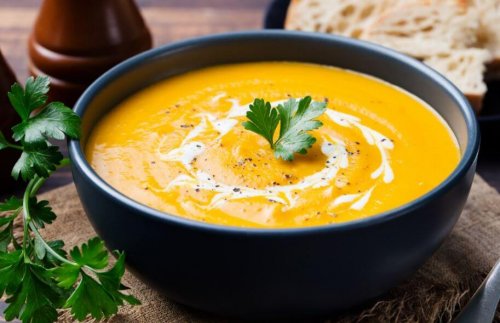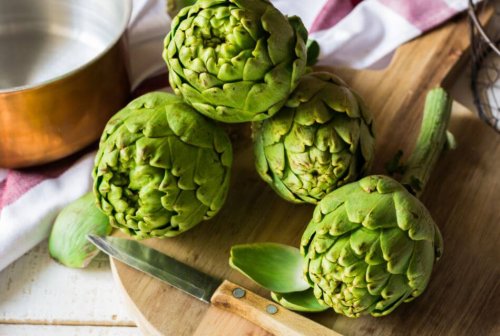Learn About Vegetables that Help Your Digestion

Many people feel heavy and bloated after eating their meals. These inconveniences can be relieved naturally, in most cases. To achieve this, you simply need to change certain foods and choose, for example, the types of vegetables that will help you with your digestion.
There are certain foods that are very beneficial for your stomach. In order to avoid some of the inconveniences that we have mentioned, we’ll explain more about some of the vegetables that make digestion easier.
Three vegetables that help digestion
1. Pumpkin
Pumpkin is a light food, low in calories with a high fiber content. These three properties make it easy to digest and avoid unpleasant sensations that occur with heavy digestion. Besides, pumpkins contain potassium, which helps prevent and eliminate liquid retention.
For all of this, pumpkins are a great ally against heavy digestion. Our recommendation is that if you’re preparing an overwhelming, heavy main course, choose an appealing cream of pumpkin for the first course. If you decorate it with caramelized onion and a touch of parsley, it will be perfect, even on the most special of occasions.
How to make this cream of pumpkin? It’s very simple. Just boil a piece of pumpkin, a potato and half a leek in a pot. You may also include other vegetables, if you’re looking for a more gentle taste. After cooking for 20 minutes, you just need to blend it and serve.
Another option is to place several pieces in the oven and add a small amount of olive oil and salt. Bake for half an hour and put aside. This simple recipe is a perfect garnish to eat with meat and fish.

2.Artichokes: vegetables that aid digestion
Artichoke is a food with many properties. To prove it, you just need to see the number of diets and weight loss plans that include this vegetable.
One of the main reasons is that only 100 grams of artichoke provide half the daily fiber requirement. This huge amount of fiber stimulates your bowel movements and favors the digestion process.
Besides, the artichoke is also used in diets because it has great diuretic power. This is why, it helps eliminate excess liquid in the body and avoids them accumulating, which could otherwise cause swelling and bloating.
Cooking artichokes is very simple and you only need to be careful when cleaning them. First, you must remove the outer leaves until you expose the inner yellow leaves.
If you don’t remove the outer leaves, the artichokes will taste bitter. Then, you need to boil them for 15 minutes. When they’re done, you just need to cook them with onions and sautéd ham to enjoy a real delicacy.
 3. Celery
3. Celery
Celery is one of the lightest vegetables, every 100 grams you eat of this vegetable contains only 10 calories. It’s practically nothing, this makes this nutrient essential in any diet.
Besides, when we eat celery, our stomachs produce more gastric acids. Therefore, digestion occurs in an easier way.
The recipe we propose you prepare is perfect for serving as an entree or in a dinner. Besides, it’s healthy and light, so you can eat it without any problem.
This preparation consists of chopping the celery in 5 to 6 centimeters pieces. Then, prepare a mix with cream cheese, dried fruits and diced shrimp. Finally, stuff this into the celery strips and serve.
Ending heavy digestion is possible thanks to these vegetables. Due to their high fiber and low-calorie contents, they’re perfect for stimulating and enabling the digestive process. Besides, with the dishes we’ve proposed, taking care of yourself will be a delight.
Many people feel heavy and bloated after eating their meals. These inconveniences can be relieved naturally, in most cases. To achieve this, you simply need to change certain foods and choose, for example, the types of vegetables that will help you with your digestion.
There are certain foods that are very beneficial for your stomach. In order to avoid some of the inconveniences that we have mentioned, we’ll explain more about some of the vegetables that make digestion easier.
Three vegetables that help digestion
1. Pumpkin
Pumpkin is a light food, low in calories with a high fiber content. These three properties make it easy to digest and avoid unpleasant sensations that occur with heavy digestion. Besides, pumpkins contain potassium, which helps prevent and eliminate liquid retention.
For all of this, pumpkins are a great ally against heavy digestion. Our recommendation is that if you’re preparing an overwhelming, heavy main course, choose an appealing cream of pumpkin for the first course. If you decorate it with caramelized onion and a touch of parsley, it will be perfect, even on the most special of occasions.
How to make this cream of pumpkin? It’s very simple. Just boil a piece of pumpkin, a potato and half a leek in a pot. You may also include other vegetables, if you’re looking for a more gentle taste. After cooking for 20 minutes, you just need to blend it and serve.
Another option is to place several pieces in the oven and add a small amount of olive oil and salt. Bake for half an hour and put aside. This simple recipe is a perfect garnish to eat with meat and fish.

2.Artichokes: vegetables that aid digestion
Artichoke is a food with many properties. To prove it, you just need to see the number of diets and weight loss plans that include this vegetable.
One of the main reasons is that only 100 grams of artichoke provide half the daily fiber requirement. This huge amount of fiber stimulates your bowel movements and favors the digestion process.
Besides, the artichoke is also used in diets because it has great diuretic power. This is why, it helps eliminate excess liquid in the body and avoids them accumulating, which could otherwise cause swelling and bloating.
Cooking artichokes is very simple and you only need to be careful when cleaning them. First, you must remove the outer leaves until you expose the inner yellow leaves.
If you don’t remove the outer leaves, the artichokes will taste bitter. Then, you need to boil them for 15 minutes. When they’re done, you just need to cook them with onions and sautéd ham to enjoy a real delicacy.
 3. Celery
3. Celery
Celery is one of the lightest vegetables, every 100 grams you eat of this vegetable contains only 10 calories. It’s practically nothing, this makes this nutrient essential in any diet.
Besides, when we eat celery, our stomachs produce more gastric acids. Therefore, digestion occurs in an easier way.
The recipe we propose you prepare is perfect for serving as an entree or in a dinner. Besides, it’s healthy and light, so you can eat it without any problem.
This preparation consists of chopping the celery in 5 to 6 centimeters pieces. Then, prepare a mix with cream cheese, dried fruits and diced shrimp. Finally, stuff this into the celery strips and serve.
Ending heavy digestion is possible thanks to these vegetables. Due to their high fiber and low-calorie contents, they’re perfect for stimulating and enabling the digestive process. Besides, with the dishes we’ve proposed, taking care of yourself will be a delight.
All cited sources were thoroughly reviewed by our team to ensure their quality, reliability, currency, and validity. The bibliography of this article was considered reliable and of academic or scientific accuracy.
- Kim, M. Y., Kim, E. J., Kim, Y. N., Choi, C., & Lee, B. H. (2012). Comparison of the chemical compositions and nutritive values of various pumpkin (Cucurbitaceae) species and parts. Nutrition Research and Practice, 6(1), 21–27. https://doi.org/10.4162/nrp.2012.6.1.21
- Cruzado, M., Pastor, A., Castro, N., & Cedrón, J. C. (2013). DETERMINACIÓN DE COMPUESTOS FENÓLICOS Y ACTIVIDAD ANTIOXIDANTE DE EXTRACTOS DE ALCACHOFA (Cynara scolymus L.) 1 1 2* DETERMINATION OF PHENOLIC COMPOUNDS AND ANTIOXIDANT ACTIVITY OF ARTICHOKE EXTRACTS (Cynara scolymus L.). Rev Soc Quím Perú (Vol. 79). Retrieved from http://www.scielo.org.pe/pdf/rsqp/v79n1/a08v79n1.pdf
- Crozier, A., Lean, M. E. J., McDonald, M. S., & Black, C. (1997). Quantitative Analysis of the Flavonoid Content of Commercial Tomatoes, Onions, Lettuce, and Celery. Journal of Agricultural and Food Chemistry, 45(3), 590–595. https://doi.org/10.1021/jf960339y
This text is provided for informational purposes only and does not replace consultation with a professional. If in doubt, consult your specialist.








